The Straits Times published a letter from the Singapore Heritage Society and All Things Bukit Brown 15th May, 2014 in response to an ed-op piece ” Can Civic Society Influence Policies on 12th May. The edited letter is available here
We reproduce the original and highlight key parts which were edited :
We refer to the article by Assistant Political Editor Leonard Lim claiming that civil society groups “extracted concessions on Bukit Brown cemetery” in his opinion piece, “Can Civil Society Influence Politics?” (ST, May 12, 2014).
As key players of the civil movement trying to protect and preserve Bukit Brown, we are unclear as to what “concessions” Mr. Lim is referring. It is now a well-established narrative that officially in 2012 when the road was announced, the decision to build a highway through Bukit Brown had already been made. We state for the record we were present at a briefing by the Ministry of National Development but that there was no consultation or protracted engagement thereafter to extract any concessions. We issued a call for a moratorium and moved on.
Mr. Lim references a subsequent decrease in the number of graves planned for exhumation for the 8-lane road across Bukit Brown from an estimated 5,000 as part of a compromise reached with civil society. This is not the case.
There are two points to clarify to prevent this misstatement of facts from being (repeatedly) perpetuated. One, the number of graves finally affected was reduced not to 3,764 as stated in Lim’s article, but to 4,153. The error occurred because Mr. Lim quoted from a Land Transport Authority (LTA) announcement in a March 19, 2012 statement on the realignment of the road. It was in an August 5, 2013 statement by Urban Redevelopment Authority (URA) and LTA to announce the award of the contract for the road that the final tally of affected graves was issued. Two, both statements clearly attributed the realignment of road to an engineering decision, and the drop in the number of graves affected had nothing to do with consultations with civil society.
On the second point, we draw attention to the LTA statement that announced that the road design includes a bridge over several creeks in Bukit Brown rather than a design that will see a filling up of these natural drainage networks with soil. There was no consultation on the original design or its changes. It is not clear if the adjustment was a result of a yet-undisclosed, but limited-scope Biodiversity Impact Assessment that the LTA conducted in early 2012. Regardless of the reason, that this change in design has been reported several times in your newspaper to be a result of a “compromise” with civil society is erroneous and needs to be corrected so as not to be repeated.
To date, there is likewise no consultation about the zoning of the greater Bukit Brown area in its entirety for residential use in the 2013 Draft Land Use Master Plan released by the URA. This area includes the larger cemetery complex comprising Bukit Brown, Seh Ong, Lau Sua, and Kopi Sua.
Now that we have clarified the events of 2012 and the decisions announced thereafter on official record, we would like to focus on the present and note that we have been meeting with the National Heritage Board since mid-2013 and hope to make more progress in protecting Bukit Brown. We write to clear the air so discussions are based on facts, not misrepresentations, and the public is not misled.
Signed:
Chua Ai Lin (Dr) President, Singapore Heritage Society, Claire Leow (Ms) co founder, All Things Bukit Brown
****
The original article reproduced here for reference, highlighted paras on Bukit Brown :
ST Opinion, May 12, 2014
Can civic society influence policies?
By Leonard Lim, Assistant Political Editor
THE large, spreading banyan tree once had such a thick canopy that little sunlight could filter through, hindering the flourishing of any plants below.
But, to borrow this metaphor of the State made famous by former minister George Yeo in 1991, it has been pruned somewhat in the past couple of years.
Consultation and engagement have become the buzzwords of government policymaking in a changed political landscape, with a more well-educated, well-travelled populace becoming more assertive and vocal.
There may be no better time for civil society – the wide spectrum of organisations operating outside the government and business sectors – to test this pledge to listen more, and in the process carve out a more influential role for itself.
They can take heart from the naming of Mr Tan Chuan-Jin last year as the Government’s unofficial point person for engaging with non-governmental organisations (NGOs). Mr Tan is Manpower Minister and a member of the fourth-generation leadership.
In 2012, Law and Foreign Minister K. Shanmugam met gay activists to discuss matters such as discrimination and the anti-gay sex law Section 377A.
The State’s engagement with other interest groups on animal rights, heritage and conservation as well as environmental awareness has also increased.
Civil society has scored significant victories recently as well, influencing legislation and government policy.
Since the start of last year, foreign maids – either with a new work permit or a renewed one – have been entitled to a day off every week, or must be paid a day’s wages in lieu.
As contracts last two years, all maids will, by next January, be on new contracts that have to abide by the rule. The change came about after a decade of lobbying from groups championing the rights of migrant workers.
Laws on sexual crimes have also been repealed.
It started in late 2011, after an article highlighting a little-known section of the Evidence Act was put up on website publichouse.sg. The Act allowed a man charged with rape to discredit the victim by digging into her sexual history, and showing she is of generally immoral character.
Mr Andrew Loh, who runs the site, circulated the post to several ministries to get a response.
He received a call from the Law Ministry suggesting a meeting, but turned it down as he felt the Association of Women for Action and Research (Aware) was the expert on the topic.
Mr Shanmugam eventually met representatives from the women’s rights advocacy group and later started the process of amending the Act.
Nature lovers, who in 2001 succeeded in getting the reclamation plans for the Chek Jawa wetlands area shelved, also extracted concessions on Bukit Brown cemetery recently.
Several nature and heritage groups opposed the construction of a road that would slice through the historic graveyard.
It is the largest Chinese cemetery outside China, and among the thousands of graves are those of philanthropist Gan Eng Seng and Lee Hoon Leong, grandfather of founding prime minister Lee Kuan Yew.
After months of engagement, a compromise was reached and the authorities changed the road’s design so that the number of graves exhumed fell from 5,000 to 3,746.
But there are also many examples where civil society’s push for change was not successful.
Earlier this year, several activists took issue with the Government’s tabling of proposed legislation to keep the peace in Little India following last December’s riot.
They argued that the parliamentary Bill placed too much focus on alcohol as the cause of the riot, and this might influence a Committee of Inquiry’s deliberations.
Several non-partisan Nominated MPs criticised aspects of it. But it was passed, with the Government explaining that the new laws would give the police powers in the neighbourhood for a year until longer-term measures could be enacted.
Other recent civil society proposals that were rebuffed include calls to introduce a poverty line to reduce income inequality, and the withdrawal of licensing regulations of news websites, which some saw as onerous and curbing free expression.
But groups can take heart that “the Government has and will continue to engage civil society as an essential partner in dealing with the important issues that face Singapore”, as Mr Shanmugam’s press secretary wrote in a letter to The Straits Times Forum page last November.
Still, even as the political leadership indicates a greater willingness to engage, there is always the lingering question mark over whether a civil society group’s actions or statements are deemed to have crossed into the political arena, thus risking censure from the Government.
This longstanding stance of politics and political comment belonging only in the realm of party politics can be traced back to the fledgling days of the People’s Action Party.
In the 1960s and 1970s, leftists used trade unions and cultural groups to garner support against the party.
A recent incident involved activist Nizam Ismail.
In April last year, the lawyer was accused by the Government of using the Association of Muslim Professionals (AMP) as a platform for pursuing partisan and racial politics, a claim which he denied.
He resigned from his AMP leadership positions, saying he was told the Government had taken issue with his online comments and participation in political events that he said he did in his “personal capacity”.
In the wake of the furore, Mr Lawrence Wong, Minister for Culture, Community and Youth, said in May last year that the Government welcomes feedback on policies even if they may be critical, as this helps improve public policy for the benefit of all Singaporeans.
But NGOs “should not be used as a cloak for partisan political objectives”, he stressed.
“Similarly, while individuals in the NGOs are free to express their views, they should not use their organisations to pursue a partisan political agenda,” he added.
The goals of civil society in wanting social transformation, however, mean these limits will inadvertently be tested on occasion.
Still, if the saplings under the banyan tree are to take root and thrive, much will depend on how willing Singapore’s civil society is to push the boundaries and extend its reach in this new landscape.
limze@sph.com.sg
By Perry Tan, Standard Chartered Bank
On a misty Saturday morning, 33 volunteers from Standard Chartered Bank congregated at a most unlikely venue – Bukit Brown Cemetery.
This is no ordinary cemetery. Home to 100,000 tombs, Bukit Brown which opened in 1922 as a municipal cemetery is part of a complex of older adjoining clan cemeteries. The complex is the biggest outside of China. Its historical significance is substantial, and include tombs that date back to the last days of the Qing dynasty from the 1840s which were relocated from private burial grounds and clan cemeteries which had to make way for development. Bukit Brown is listed on the World Monuments Watch list 2014 as a heritage site threatened by the development of an 8 lane highway.
Armed with water bottles, shovels, saws, garden shears and other equipment, we were ready to explore the cemetery and clean up some of the tombs.
We were joined by seven Brownies, veteran citizen volunteers who dedicate their time and expertise to preserving Bukit Brown. The Brownies were our tour guides and provided cleaning work supervision, while we played tourists before offering our helping hands in tomb cleaning.
We started with the Brownies taking us on a walking tour that educated us on the history, culture, and heritage of the cemetery, as well as the rich stories of the men and women who were laid to rest. Bukit Brown is the final resting place for many famous pioneers of Singapore. We walked through the dirt tracks, stopped by prominent tombs and listened to numerous stories of many pioneers of Singapore – educators, scholars, doctors, businessmen, bankers, philanthropists, and the common men who built up the city state during its early days. Many of the names, like Chew Joo Chiat, Chew Boon Lay and Gan Eng Seng, were names that were not unfamiliar to us.
Next, we literally rolled up our sleeves and split into groups. Supervised by the Brownies, we proceeded to clean up several tombs that had been covered with vegetation, roots and dirt, restoring dignity to the pioneers resting below. We pulled weeds and shrubs, chopped at overgrown roots and dangling branches, scraped and removed algae, swept away fallen leaves, and wiped grime off the tomb stones. It was a good solid three hours of sweaty and grubby hard work, but the sense of satisfaction was immeasurable when we inspected our handiwork at the end of the session, knowing that we made a contribution towards the preservation of a heritage site of such significance.
The day culminated in a finale where we trekked to the magnificent tomb of Ong Sam Leong, where we were treated to a top-of-a-hill view and stories of the biggest tomb in Bukit Brown.
At the end of the day, we shook hands to express mutual appreciation with the Brownies. Something tells us that this would not be the last community activity at Bukit Brown as several volunteers have expressed their desire to be back for more.
***
The Standard Chartered Clean-up took place on Saturday 26 April 2014
All Things Bukit Brown organised a media session to meet the volunteers aka Brownies to share their hopes and aspirations for Bukit Brown, following the World Monuments Watch listing. We are grateful to Jasmine Ng for videographing the session.
http://www.youtube.com/watch?v=4j-BTwQlWos&feature=youtu.be
Part II of the recording with interviews to the media by Claire Leow and Fabian Tee (in Mandarin)
http://www.youtube.com/watch?v=CVjFZ4UuIeY&feature=youtu.be
The summary of media coverage here
All Things Bukit Brown broke the news that Bukit Brown had been included on the list of the World Monuments Watch 2014, on the evening of Tuesday 8th October, 2013. It was the first listing for Singapore, and international recognition of Bukit Brown as a heritage site.
24 hours later, on Thursday 10th October, 10 am, a media session to meet the Brownies behind the submission to the World Monuments Fund, was held at Bukit Brown, under the rain tree at the roundabout. It was an appropriate setting, as this is the spot where all our guided walks begin.
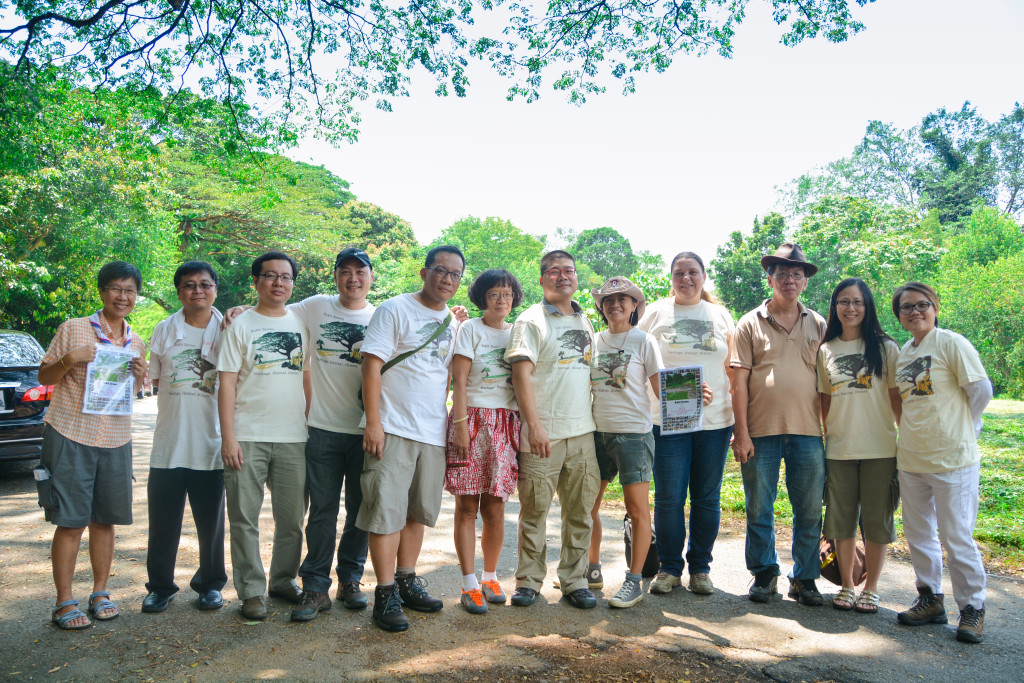
Supporters and the Brownies behind the submission for World Monuments Watch 2014 listing (photo Terry Xu)
Full video recording by Jasmine Ng here
This is a compilation of highlights and quotes of the media coverage online, in the press and in the broadcast media from 9 October to 13 October, 2013
10 October Channel News Asia TV report on Bukit Brown’s World Monuments Watch listing.
Interest group hopes that this(the listing) will lead to more engagement and a more sustainable strategy for development. Claire Leow “We hope this listing by shining international attention on Singapore will also help Singapore’s bid to get UNESCO listing for Botanic Gardens and of course eventually Bukit Brown as well and eventually other sites as well in Singapore”
The full CNA TV report here
Claire Leow, co-founder of All Things Bukit Brown, said: “It goes beyond what we’ve done for Bukit Brown; it’s more like what we can do for Singapore.
She added: “I hope it shows that we are serious, that we want a seat at the table, just so we can present what we have heard from the community, what we have heard from the people who have encouraged us, and we can share their voices too.
The full online CNA report here.
10 October Zaobao
“I hope to use this opportunity open a dialogue with the government and find a sustainable path to development. I do not think that conservation of heritage monuments and development has to be confrontational. On the contrary, we hope that conservation can aid development and vice-versa“
She pointed out that at present, talks about development and conservation are always framed in terms of trade-offs – e.g. do we want to keep land for our ancestors or make room for our descendants. Why do we not talk about other issues, e.g. are we not willing to let go of a site that could potentially be a world heritage site? In the face of global warming and the need for nature to maintain stable temperatures, can we afford to lose a site of certain environmental value to us? Claire Leow.
The full Zaobao report with translation here
10 October The Online Citizen (TOC)
“There’s more to Bukit Brown, than my own family. And I realised the things I do not know about this place and it’s going to go. And that nothing will be left for my children, grandchildren and great grand children. ” Ong Hui Lin (descendant with 3 ancestors buried in Bukit Brown)
“Yes Bukit Brown is now on the World Monument Watch but it is more than that. We nominated Bukit Brown because it is significant to our history, culture and society. I hope that this will prompt people to look into all 3 aspects.” Claire Leow
The full video report on TOC here
10 October Razor TV online
“Now with the listing, it gives credence to the fact that this is a world class heritage site. So my sense is that one has to think again about the questions,, I appreciate the challenges that urban planners face. But maybe they don’t have a larger picture and that larger picture is history and heritage, history that affects out identity” Chew Kheng Chuan (descendant with 8 ancestors buried in Bukit Brown”
“I am very mixed because I am a road user and I love homes. Homes for my children. But for Bukit Brown, it is very painful because when we lose it, we would never get back the very essence. the soul” Ong Hui Lin (descendant with 3 ancestors buried in Bukit Brown)
The full online video of Razor TV here
10 October the breakfast network
“They (All Things Bukit Brown) hope more researchers, historians, cultural studies students et cetera would step up and get involved in Bukit Brown in one way or another. “We need to think differently; we need to reframe the conversation,” said Ms Leow, who wanted people to stop seeing the trade-off as space for the living vs space for the dead. Rather, she wants to foreground Bukit Brown as a potential world monument site, with environmental value, that is at stake.
The full report of the breakfast network available here.
All Things Bukit Brown clarifies on the report : We did not submit the application for World Monuments Watch listing to “throw a spanner in the roadworks”. We submitted it because we wanted recognition, to heighten awareness and draw attention to Bukit Brown as a heritage and nature site worthy of preserving.
10 October (The Economist) Banyan Blog
“In an interview republished in his latest book, Lee Kuan Yew, Singapore’s elder statesman, who left the cabinet two years ago but still reflects the views of many in the government he led for so long, is, characteristically, yet more blunt in an interview reprinted in his latest book: “if we need the land, and we have to dig up the whole of Bukit Brown to build on it, and put the ashes in a columbarium, we will do it.”
The Brownies point out that the government presents a false choice between space for the dead and space for the expanding population that Singapore needs to sustain its growth. Bukit Brown is also for the living, and for future generations interested in how Singapore became what it is today.”
The full report on the Banyan here
10 October : Singapore Heritage Society statement on the listing:
This is the first time a Singapore site has been included in the World Monuments Watch. Together with the Singapore Botanic Gardens’ UNESCO nomination, Bukit Brown’s inclusion represents widespread international recognition of the historical importance of local heritage sites. Indeed, Bukit Brown’s narrative of early immigrants and regional histories complements the Botanic Garden’s narrative of colonial empire to provide a more complex and complete story of Singapore.
13 October Yahoo News
“With the World Monuments Watch listing, the first time a site in Singapore has been included, atBB thinks that Bukit Brown and the Gardens, which are located fairly close to each other, could be paired up for a stronger nomination, said (Catherine) Lim.
“What we’re saying is there’s an opportunity here to relook our application (to UNESCO),” she said. “It has started, but it’s going to take two years (to complete), so why not explore? We’re offering up an opportunity of a possibility… It’s for the government to consider this. I’m not sure whether they actually have considered the actual status that’s accorded Bukit Brown being on the list.”
The full report on Yahoo News here
A Question of Public Value : Bukit Brown . a thought essay by Z’ming Cik was submitted for the “My Say” category of the blog on 13th October.
9 October 2013 Straits Time (ST) Report
SINGAPORE’S Bukit Brown Cemetery has been named as an at risk site on the 2014 World Monuments Watch – a biennial listing by the World Monuments Fund which compiles cultural heritage sites that are threatened around the world.
Bukit Brown Cemetery, where the graves of pioneering Chinese immigrants to Singapore since the mid-nineteenth century stand, is one of 67 sites from 41 countries and territories.
More on the ST report here
9th October Channel News Asia (CNA) Report
SINGAPORE: Singapore’s Bukit Brown Cemetery has been placed on the 2014 World Monuments Watch, which compiles cultural heritage sites threatened around the world.
More CNA report here
All Things Bukit Brown clarifies on the report below by ST News October 10, 2013 : When asked by the reporter about the call for a moratorium to stop road works issued in March 2012, the a.t.bb’s response was “we have moved on from that” as opposed to what was reported ” the group, which hosts weekly guided tours at the site, is also sticking to a call it made last year for a moratorium on plans for Bukit Brown and for more public engagement with the Government.”
ST News Oct 10, 2013
All Things Bukit Brown, an interest group which is keen to preserve the site’s heritage and habitat, nominated it to the New York-based World Monuments Fund watch list. It was picked from 248 nominations – making it the first time that a Singapore site has made it to the list. The WMW citation said of the road and redevelopment of the site: “In destroying the cultural landscape of Bukit Brown, it is a loss to all of society.”
The non-profit World Monuments Fund has issued its watch list since the 1990s to raise awareness about threatened cultural sites. It has helped to helped restore sites in more than 90 countries, including the historic enclave of Georgetown in Penang .
The full ST report here
From The Diplomat on 30 October 2013
Abstract : “We must be reminded that there are other land uses that take up enormous amounts of space, yet hardly anyone is questioning the utility of those spaces. Singapore has 18 golf courses, one of the highest numbers per country area in the world. They take up a total of 1,800 hectares. By contrast, Bukit Brown takes up 233 hectares; one-ninth of that area. Does Bukit Brown seem very big now?”Else Teo, a freelance researcher specialising in history and heritage issues.
by Szeto Hiu Yan
The World Monuments Fund (WMF) select sites that are under threat on its watch list once every 2yrs. 3 days ago, they announced the 2014 list which included 67 sites from 41 countries selected from a list of 248 applications.
At a news conference held on location yesterday, a.t.BB (All Things Bukit Brown) said that the successful listing did not imply that it is putting pressure on the government or is attempting to block the impending construction of the road which would affect some graves.
As one of the founders of atBB, Claire Lim said “I hope to use this opportunity open a dialogue with the government and find a sustainable path to development. I do not think that conservation of heritage monuments and development has to be confrontational. On the contrary, we hope that conservation can aid development and vice-versa. “
She pointed out that at present, talks about development and conservation are always framed in terms of trade-offs – e.g. do we want to keep land for our ancestors or make room for our descendants. Why do we not talk about other issues, e.g. are we not willing to let go of a site that could potentially be a world heritage site? In the face of global warming and the need for nature to maintain stable temperatures, can we afford to lose a site of certain environmental value to us?
Claire is of the opinion that government and society should take this opportunity to reframe the conversation and exercise our mutual imaginations to allow more perspectives to bear on this matter. This frame of mind will expand the possibilities in our dialogue.
a.t.BB also shared its plans for Bukit Brown in their application to WWF. They hope to collaborate with National Heritage Board (NHB) and NParks and turn Bukit Brown into a cultural heritage site and a nature park to attract visits. Bukit Brown will retain most of its original state with the addition of basic facilities such as rest rooms. a.t.BB will continue to provide free guided walks and to increase its community outreach especially towards the young.
With the listing, a.t.BB hope to heighten overall public awareness of BB’s repository of cultural heritage both locally and abroad. E.g. instead of expensive overseas trips to learn about culture and heritage , educational institutions could look first at visits to local sites. a.t.BB also hopes to promote edu-tourism by attracting more visits by foreign students and overseas academic scholars.
As the a.t.BB current expenses are still manageable, it does not have any plan to apply for WWF funding.
According to Catherine Lim, another founder, WMF routinely provides assistance to countries that wish to elevate WMF sites to UNESCO sites. She therefore hopes that Singapore’s current UNESCO application for Botanical Gardens could in future be twinned with Bukit Brown to increase the chances for both sites to be listed. a.t.BB also hopes that it could work closely with Penang and Malacca as UNSECO sites, to raise the profiles of both countries’ cultural heritage
Catherine said that since the founding of BB in Dec 2011, over 7,000 people have been acquainted with Bukit Brown, through the free tours conducted by it. a.t.BB could also learn from the other WMF listed sites about how to raise awareness of BB.
The report first appeared in Zaobao on 11 October 2013 and is translated by Brownie Fabian Tee.
Zaobao’s Sunday 13 October round-up of quotable quotes also included the quote by Claire Leow:
“I absolutely do not think that the dialogue between preservation and development is necessarily confrontational. I hope that preservation of cultural heritage can aid urban development and vice-Versa.” – said co-founder of all things Bukit Brown Claire Leow who expressed the hope that that the listing of BB in the World Monuments Watch 2014 would open more channels of dialogue to find a common path for sustainable development.
The Chinese report follows:
武吉布朗学会: 武吉布朗列世遗观察名单并非向政府施压
司徒晓昕 报道
szetohy@sph.com.sg
武吉布朗坟场成功列入世界历史遗址观察名单后,负责申遗的武吉布
世界历史遗址基金会(World Monuments Foundation)每两年选出濒危的世界遗产,将之列入观察
武吉布朗学会(All Things Bukit Brown)昨早在武吉布朗举行的记者会上表示,武吉布朗成功申
学会创办人之一廖雪珠说:“我们希望趁此机会展开更多对话,一起
她指出:“我们在讨论这个课题时总要提到权衡的问题,而这最后往
廖雪珠因此认为,政府和社群应趁此机会重塑对话的方式,大家应该
武吉布朗学会也叙述了申列过程中,向世界历史遗址基金会提出的未
如今武吉布朗列入了观察名单,学会希望这能提高国人和国际人士对
由于学会目前的经费不高,因此不打算向世界历史遗址基金会申请资
另一名创办人林雪芳说,世界历史遗址一向为希望申列世界遗产名录
她说:“学会自2011年12月创立后开始提供免费导览团,至今
武吉布朗学会希望在武吉布朗坟场成功申列世界历史遗址观察名单后
本地和外国人对武吉布朗的认识能有所提高。(谢智扬摄)
A Question of Public Value : Bukit Brown
by Z’ming Cik
(14 October 2013)
It has been a sweet triumph of sorts for the heritage enthusiasts of Bukit Brown who dub themselves the ‘Brownies’. They have now managed to earn international recognition for the site by placing it on the 2014 World Monuments Watch – even if that does not seem likely to change the government’s immediate plans to build a highway cutting through it.
It is not just an affirmation of its significance that Bukit Brown has been selected, alongside Venice in Italy, Yangon historic city centre in Myanmar and sites in war-torn Syria such as a 17th-century souk in Aleppo, as one of 67 cultural heritage sites currently “at risk from the forces of nature and the impact of social, political and economic change” – in the words of the New York-based World Monuments Fund.
It is also an affirmation of a universalistic ethos that any cultural heritage of the world can transcend the narrow confines of ethnic identities, and be protected by all mankind, against irreplaceable loss due to unchecked urban development or other factors. Such is indeed also the true spirit behind the 1972 UNESCO World Heritage Convention, best known for the mechanism of the world heritage list, on which Singapore is attempting to inscribe its Botanic Gardens.
The purpose of this little article here is not to make a case for the nomination of Bukit Brown as a world heritage site – though that can definitely make a fruitful exercise, given its historical and aesthetic values based on all the knowledge accumulated. Instead, I would like to approach the issue of Bukit Brown from a more general perspective, of what is stake in general with plans to sacrifice such a site for traffic and future residential use, and how decisions should be arrived at from the perspective of public administration. For as the Brownies have expressed at a press conference last week, there is an urgent need to ‘reframe’ public discussion, away from a false dichotomy that treats it as a choice between space for the dead and space for the living.
Indeed, the issue of Bukit Brown is not a dilemma between past and future, tradition and modernity, heritage and progress, or community and nation. It may be framed instead as a question of ‘public value’ for the average Singapore citizen, whereby one should weigh between the gains of constructing a highway to ease traffic (and allowing more cars on the road) and the environmental costs which may impact on the quality of life for all residents, not to mention the opportunity costs in compromising a heritage site with value in education and tourism use.
I am borrowing the term ‘public value’ here from Mark H. Moore, Kennedy School of Government, Harvard University, author of the book Creating Public Value. Under such a framework of public administration, one may discuss whether a public enterprise reflects the desires or aspirations of the citizens, and also analyse whether it is cost-effective for collective interests.
This gives us a clearer picture of the problem when we consider the following points. First, in terms of desires or aspirations, 54% of Singaporeans according to the recent Our Singapore Conversation Survey have expressed a preference for preservation of heritage spaces over infrastructure, and 62% have expressed a preference for preservation of green spaces over infrastructure. The Singapore Heritage Society also cites an earlier Heritage Awareness Survey whereby 90% of Singaporeans agree that preservation of heritage would become more important as Singapore becomes a global city.
Second, plans for the 8-lane highway through Bukit Brown were announced without full disclosure of its Environmental Impact Assessment, which should rightly be of public interest. Nature Society has cited the importance of Bukit Brown as a green lung with cooling effects on the climate and mitigating effects against flash floods. We have surely seen how Urban Heat Island (UHI) effects, due to increased urban surfaces and industrial and car emissions, lead to more flash floods. The National Environment Agency is now advising Singaporeans to brace for warmer and wetter days in the next century. Should Singaporeans be inspired then to make extra more babies? Would more population growth and urban development be sustainable in the long run?
The idea of ‘sustainability’ is incidentally concerned not only with economic development but also with environment and social equity; it begs us to rationalise the needs of the present generation, in order not to compromise the ability of future generations to meet their own needs. So who are we to decide for the future generations that they have no need for natural green spaces, for authentic cultural and natural heritage?
Third, an 8-lane highway may be cost-effective for the operations of LTA and its contractors, but is it ‘cost-effective’ for all Singaporeans? On the concern of infrastructure alone, will the benefits be well distributed among Singaporeans? I believe a lot of Singaporeans would prefer to see improvements in public transport – whereby they should be managed as public enterprises rather than as profit-making private enterprises, while controlling the growth or inflow of population meantime. COEs this month have just reached 90K, and ERP rates have been rising too, so how does a new highway represent the interest of the average Singaporean? Should the dictum of the government be what former head of Civil Service, Ngiam Tong Dow recalls: “What’s wrong with collecting more money?”?
An 8-lane highway may make good business sense if the objective is to attract higher demands for car traffic. But it is a road of no return where environmental costs and the loss in heritage are concerned.
Perhaps the word ‘heritage’ is not always useful here, for some people may mistake it as being synonymous with ‘tradition’, and they assume that to acknowledge a cemetery dating back to the Qing dynasty as heritage would mean having to wear a pigtail, or to bow before the image of some dead old merchants and ask for 4D numbers. They imagine ‘heritage’ as a form of liability, instead of as a form of resource for an authentic experience of national history, or of works of art.
How the historical significance of Bukit Brown as ‘heritage’ should be interpreted, is certainly open to debates. But being ‘modern’ does not mean discarding everything of the past. We are not living in an era of Cultural Revolution somewhere in China. The National Heritage Board has also recognised the importance of Bukit Brown Cemetery and the need to work with the community for its preservation.
Being ‘modern’ also means being able to rationalise how one should help steer the development of one’s country or the world at large. Hopefully more Singaporeans will be able to look at the issue of Bukit Brown not as a matter of whether one has personal affinity to it, but from a perspective of public value.
We may ask ourselves: What heritage values does it hold on a local level and on a global level, and how would that represent the desires and aspirations of Singaporeans? In what circumstances would redevelopment be justifiable, and in what way would that represent social equity and long-term interests among Singaporeans?
We as Singaporeans need to rethink what this land of Singapore means to us, and what the word ‘progress’ truly means.
Z’ming Cik is pursuing his Phd in heritage studies in Germany.
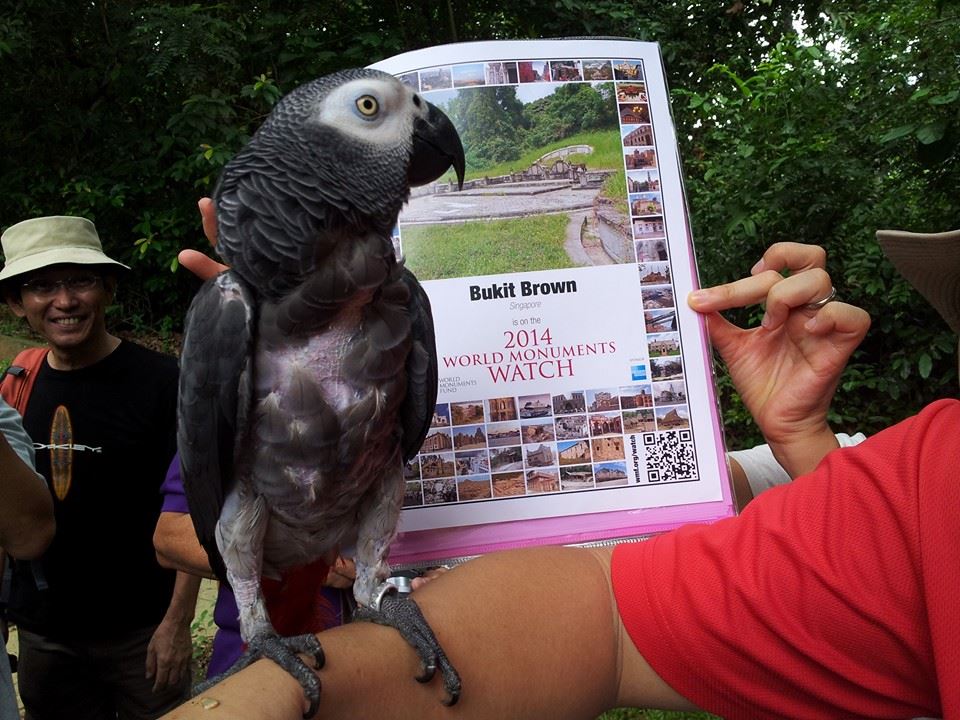
The first tour after the announcement of Bukit Brown’s World Monuments Listing. Basil the macaw weighs in on what it means (photo Khoo Ee Hoon)
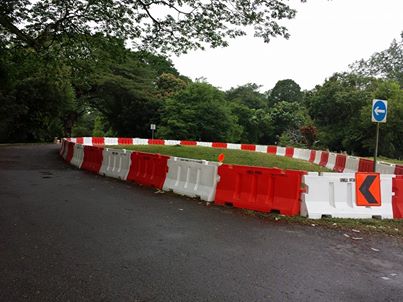
A day after the meet the media session with Brownies on the World Monuments Watch listing, the barricades are up at the roundabout (photo Milli Phuah)
NEWS FLASH: THE CHEE FAMILY HAS STEPPED FORWARD TO CLAIM MRS CHEE KIM GUAN FOLLOWING TODAY’S NEWS PAPER REPORT IN ZAOBAO , 1 OCTOBER 2013
What began as a news flash on the Facebook Group Heritage Singapore Bukit Brown Cemetery by Raymond Goh has materialised into a newspaper article calling on descendants of Mrs Chee Kim Guan, mother of Chee Yam Chuan, to lay claim to the tomb, stake number 1818.
(This is a relocated tomb, located at Hill 2, Block 3 and is one among a cluster of 1830s tombs)
On August 25th, 2013 Raymond posted:
” Newsflash – I believe I have found the mother of Chee Yam Chuan among an old cluster of tombs staked to be removed due to an impending road project. One of Chee Yam Chuan’s grandson is Chee Swee Cheng. Today I dug the soil at the bottommost of the tombstone to reveal the only grandson on the tombstone. It was Keat Bong. Next I check out David Chng record of Chee Yam Chuan tomb inscription found in Malacca. His eldest son was also Keat Bong. Based on the son and grandson inscribed in this tombstone, I can almost confirmed that this is the tombstone of the mother of Chee Yam Chuan, Mrs Chee Kim Guan nee Khoo. This tomb is dated to 1836, and the Chees’ are one of the pioneering family to come to Singapore during its modern founding in 1819″
For more on Raymond’s research on the Chee Family, please click here
Today, 1 October 2013, Zaobao published an article on the identity of who is buried in the staked tomb, which is in the way of the 8 lane highway and still unclaimed. The following is a summary of the article by PatSg one of the members of the facebook group
* 百年古墓即将起坟 峇峇富商生母之墓无人认领?
武吉布朗3746个受新道路工程影响的坟墓,10月起将逐一起坟。在2525个至今还没有后人认领的坟墓中,有一个年代可追溯到“道光十六年岁次丙申”(1837年)的清代迁葬墓,相信是马六甲和新加坡峇峇富商徐炎泉生母之墓。
* Century-old Tomb of Mother to Wealthy Baba Merchant: On verge of exhumation and yet unclaimed (Lianhe Zaobao – 01 Oct 2013)
Bukit Brown’s 3,746 tombs affected by the new highway project will be exhumed starting from this October. Amongst the 2,525 unclaimed tombs is one that was re-interred in 1837 during the Qing emperor Daoguang’s 16th year of reign (also the year of the Fire Monkey). This tomb is believed to belong to the birth mother of the wealthy Malacca and Singapore Baba merchant Xú Yán Quán [徐炎泉: Chee Yam/Yean Chuan].
原籍漳州府龙溪县的徐炎泉(1819-1862)和父亲徐钦元都是海峡殖民地成功商人,曾经富甲一方,生意遍布马六甲和新加坡。徐炎泉21岁时就已经当上马六甲福建帮领袖,不过他在1862年遭枪杀,时年43岁。
Hailing from Longxi county of Zhangzhou prefecture, both Xú Yán Quán [Chee Yam/Yean Chuan] (1819-1862) and father Xú Qīn Yuán [徐钦元: Chee Kim Guan] were successful and extremely wealthy merchants of the British Straits Settlements with businesses all over Malacca and Singapore. Xú Yán Quán was already the leader of the Malaccan Hokkien community at age 21, but was gunned down in 1862 at age 43.
原来徐炎泉的这位生母,百多年来一直静静的躺在武吉布朗坟场,而且很快便要被挖走!除了徐炎泉生母,他儿子徐桂梦和媳妇周吉娘的墓也在武吉布朗。
吴安全相信徐炎泉依然有后人在新加坡和马六甲,希望他们看到报道后,能尽快与他联络,认领被遗忘多时的坟墓。
It turns out that Xú Yán Quán’s [Chee Yam/Yean Chuan’s] birth mother has been resting peacefully at Bukit Brown Cemetery for the past 100-plus years, and would very soon be exhumed ! In addition to his birth mother, the tombs of his son Xú Guì Mèng [徐桂梦: Chee Quee Bong] and daughter-in-law Zhōu Jí Niáng [周吉娘: Chew Kiat Neo] are also located at Bukit Brown.
Raymond Goh believes Xú Yán Quán [Chee Yam/Yean Chuan] have descendents still living in Singapore and Malacca, and hopes that after reading this report, they would contact him as soon as possible to claim the long-forgotten tomb.
============
Additional Genealogical Summary by PatSg
** Chee Yam/Yean Chuan (徐钦元 Xú Qīn Yuán: 24 May 1818/19/20 – 28 Jul 1862)
* Father: Chee Kim Guan (died 13 Jan 1839)
* Mother: Siok Hui (淑惠 Shū Huì: posthumous name, re-interred tomb dated to 1836)
* Wife: Tan Liat/Lian Kian
* 2 Daughters
* 10 Sons: Chee Gin Siew (alias Cheah Jin Siew), Chee Him Bong, Chee Pee Bong, Chee Teck Bong, Chee Hoon Bong, Chee Lim Bong, Chee Hee Bong, Chee Quee Bong, Chee Beck/Peck Bong, Chee Siang Bong
Editors Note: The tomb of Mrs Chee Kim Guan is part of a cluster of over 50 tombs which have been reburied in Bukit Brown. The tombstones date back to 1830s, which indicate that these would be pioneers who predate the arrival of Sir Stamford Raffles in 1819. Information on this cluster of tombs was not recorded in the Bukit Brown Burial Registry. As such the only way to identify who are buried in this cluster is first, to decipher the names and inscriptions on each individual tomb and conduct further research. This was how Raymond identified the tomb of Mrs Chee Kim Guan
Bukit Brown, Development and Possibilities for Singapore
By Ian Chong
Recent events and public discussions about public transport, the environment, and heritage should give pause to the proposed construction of the dual four-lane carriageway across Bukit Brown. Singaporeans have one last opportunity to consider the consequences of irrevocably altering the face of an important part of our nation’s natural and cultural landscape before the planned exhumations begin in October 2013. Surveys for Our Singapore Conversation indicate that 62 percent of Singaporeans prefer preserving green spaces over constructing roads and other infrastructure, while 53 percent prefer heritage preservation over infrastructure building. (OSC Survey, p. 6) Staying road construction over Bukit Brown demonstrates responsiveness to public needs.
Simply building roads, such as one over Bukit Brown, does not address the fundamental reason underlying congestion in Singapore. As Kishore Mahbubani, dean of the Lee Kuan Yew School of Public Policy, pointed out, the fundamental challenge facing road space in Singapore is sub-optimal public transport, which heightens demand for car use. (ST, Sep 14) Recent steps by the LTA to raise ERP rates and introduce new considerations for the COE underscore the fact that controlling vehicle population should be key to addressing the traffic snarling our roads. The heavy traffic on Lornie Road during rush hours comes from vehicles filtering on and off a congested PIE, an issue a road through Bukit Brown is unlikely to solve. In fact, Singapore can probably never build enough roads if current approaches to car use and public transport are not thoroughly re-thought.
Prime Minister Lee Hsien Loong’s last National Day Rally should provide more impetus for maintaining Bukit Brown in its current form. According to Mr. Lee, new plans to develop Singapore’s southern and eastern coasts along with Paya Lebar mean that, “we do not have to worry about running out of space or possibilities for Singapore. We are not at the limit, the sky is the limit! We are creating possibilities for the future.” This means that there is space for Bukit Brown in its current form in our future and those of our children.
As physical changes in Singapore become ever more prevalent, the remaining tangible markers of our unique heritage and history only grow in importance to society. This is a reality that digitisation can never fully replace or replicate.
In fact, the Prime Minister’s National Day Rally statement about being able to maintain possibilities for Singapore stands in stark contrast to National Development Minister Khaw Boon Wan’s claim that it is necessary to sacrifice Bukit Brown and nature for construction. (Zaobao, Sept. 28) Today’s Singapore is no longer in the 1960s where infrastructure development was imperative.
The haste to construct the dual four-lane carriageway – and other follow-on developments – over Bukit Brown may even be counter-productive. Flooding earlier this month serves as a reminder of the need for development projects to proceed with caution. As the NEA subsequently stated, “Rapid development and urbanisation…are likely to be significant factors which may explain this trend [of heavy precipitation leading to flooding].” (Today, Sept 13) The Expert Panel on Drainage Design and Flood Prevention Measures likewise noted, “increased urbanisation in the Stamford Canal Catchment might have been a contributing factor to the 2010 and 2011 floods…” (p. 13)
Moreover, the panel observed that “other than generating higher and faster surface run-off, increased urbanization may also bring about other impacts such as increased heat production, changes in rainfall patterns and other climate change impacts…” (p. 13) Panel recommendations to mitigate the effects of urbanisation is recognition of the relationship between rapid, large-scale development and flooding. (p.1, 9, 15, 52, 55) Notably, the Environmental Impact Assessment for the road across Bukit Brown remains unavailable for public access.
Building the road over Bukit Brown may prove to be a temporary patch rather a real solution to the challenges of congestion, and can potentially create more difficulties down the line. The LTA and URA should hold off construction until there are more comprehensive ad appropriate ways to address the environmental, heritage, traffic, and development issues that intersect at Bukit Brown.
At a minimum, there ought to be a rigorous, publicly available study first. This is a first step toward finding a more comprehensive and sustainable approach to the issues above. Halting construction clearly comes with costs, but these may be much lower that those from building the road. Singapore is worth the extra effort.
Ian Chong works at a tertiary institution. His comments are in his personal capacity. An edited version of this commentary first appeared online in Today 30 September 2013
A letter to Zaobao highlights Bukit Brown’s heritage value to Singapore and tourism (18th July, 2013)
Translated by Desmond Sham
Singapore is a young country without many interesting built up heritage.
Bukit Brown records the rich history of Singapore since its founding. It also has a unique Nanyang style tombs rarely seen in other places. It is a rare cultural heritage with character, and can be developed into an alternative tourist spot.
Cemeteries of monarchies in the world, the Chinese cemetery in the Philippines and Chin Pao San in Taiwan where the wealthy are buried, have become famous tourist spots.
Although there are no Kings and high officials buried in Bukit Brown, there are Chinese nationalists in the Qing period and the pioneers who contributed to Singapore. The whole cemetery is colourful and very diversified.
Besides different Chinese tombs of different dialect groups, there are also Western and Japanese tombs. Tombstones are written not only in Chinese, but also English, Dutch, Japanese, Thai as well as the colloquial language of the Peranakan. This is very rare in other places, and is attractive to both locals and foreigners who love history.
Singapore is a multiracial country. A “cemetery-themed” museum can be built next to the cemetery to illustrate the history of cemeteries and funeral cultures of different ethnic groups in Singapore. I’ve seen a cartoon illustrating the Emperors’ tombs and funeral rituals in China. It’s very interesting and popular with tourists. These can also represent the multiracial history and culture of Singapore, and bring new life to its heritage. It can also be a place for the citizens especially the younger ones, to gain knowledge about other ethnic groups. This will make the cemetery more meaningful.
There are many talented people in Singapore. I hope the administration can re-plan at least to preserve a large piece of Bukit Brown, and not let this valuable place with rich history be destroyed.
Letter writer : 梁舒朗
将武吉布朗发展为历史旅游景点
新加坡是一个年轻的国家,有特色的历史遗迹不多。
武吉布朗记载着新加坡从开埠至今的深远及丰厚的历史,且具有独特
世界各国的帝皇将相陵墓,菲律宾的华人坟场,台湾一些大富大贵人
虽然武吉布朗埋葬的不是帝王将相(当中有一些是满清时代中国的爱
除了大部分不同方言族群不同格式的中式坟墓外,也可见到一些西式
新加坡是一个多元种族的国家,如果能在坟场旁建造一个博物馆,以
新加坡不乏有才干的人士,希望有关当局能重新策划(至少能保留大
梁舒朗
Lianhe Zaobao (zbNOW) 10 July, 2o13 : Commentary by Ng Siang Ping 黄向京
Translated by Ang Yik Han:
A few months ago, I visited Bt Brown. I was surprised by the knowledgeable volunteer guide who led a group of more than 10 enthusiastically, explaining while resting on a stick, wearing a hat and with a towel to soak his sweat.
This group of around 20 volunteers come from a range of diverse professions. They gather on most weekends at the cemetery, taking turns to lead English and Mandarin speaking groups. Schools, organisations and foreigners have attended their tours, and they have guided a total of more than 6000 people so far. After their tours when they share generously with the public what they have learned from the tombs, they often get together for lunch and sessions of bonding and companionship, helping each other to continue to collect and record information about the cemetery. Their FB group “Heritage Singapore – Bukit Brown Cemetery” has a membership of 2636 members. (Another group “SOS Bukit Brown” has 1148 members.)
The “Bukit Brown: Our Roots, Our Future” exhibition at Chui Huay Lim is a presentation of their research findings collected in their free time over the past two years. Some of the Brownies were also speakers during the talks. Due to their efforts and that of other parties like the Nature Society, interest in Bukit Brown has increased and it has become an attraction for nature and cultural tours.
Dr David Chng, who traversed the cemeteries of Singapore and Malaysia 30 years ago, mentioned during his talk that these youngsters are even more foolish than he was then. However, touched by their stubborn persistence, he has agreed to conduct the second public talk of his life.
In this society where most spend their life working and taking care of their families, the time and money dedicated voluntarily to the cemetery by the Brownies cannot be measured. It is imbued with a sense of local identity, and a persistent belief that treasuring the past is protecting the future, like a pebble thrown onto a lake, creating waves which spread and inspire more people to become “Brownies” in the wider sense, to care about the cemetery and other public issues.
And when there are more “Brownies” who care about this land in which they live and have grown up in, giving voice to the past and the future, one’s heart is warmed, and we can see hope.


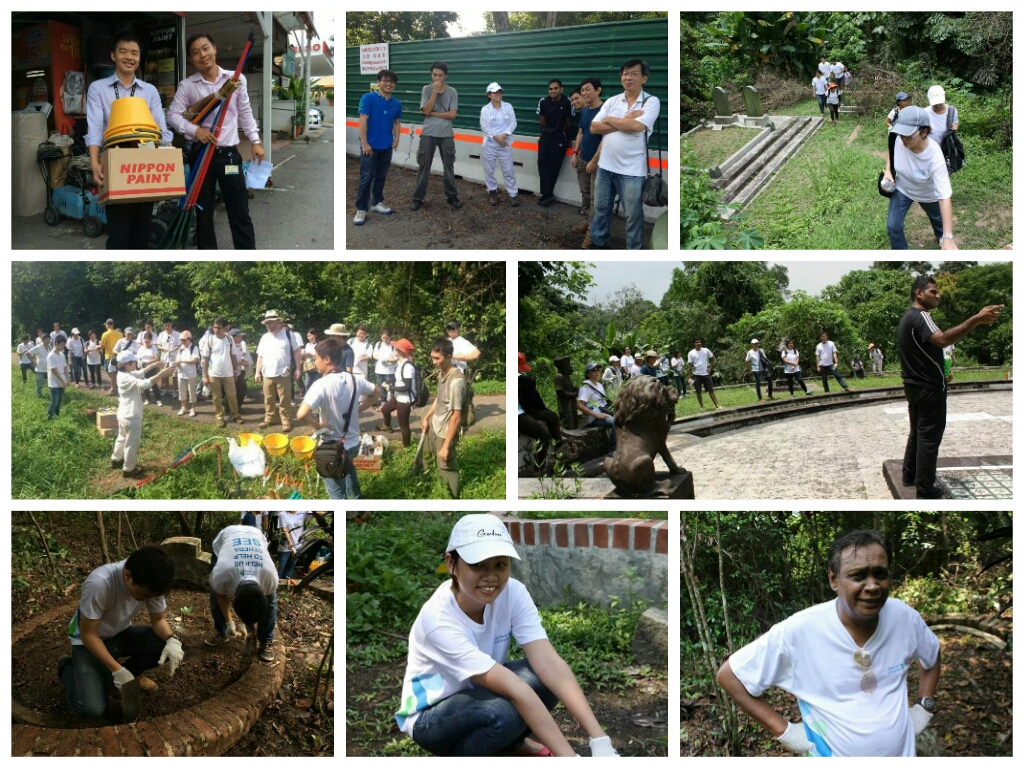

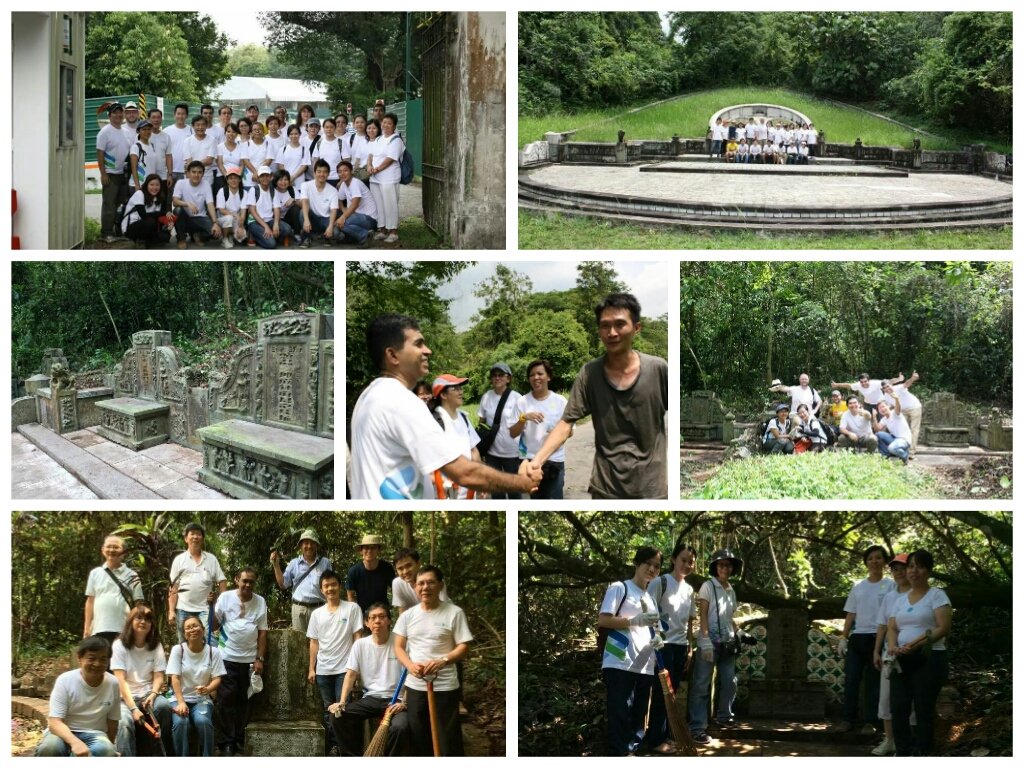

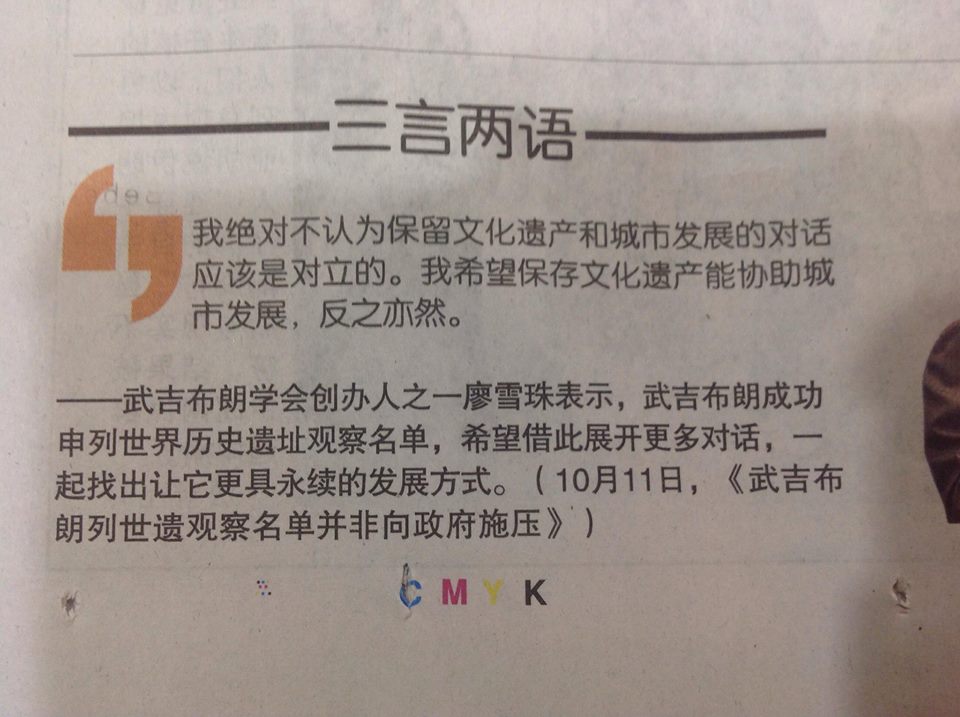

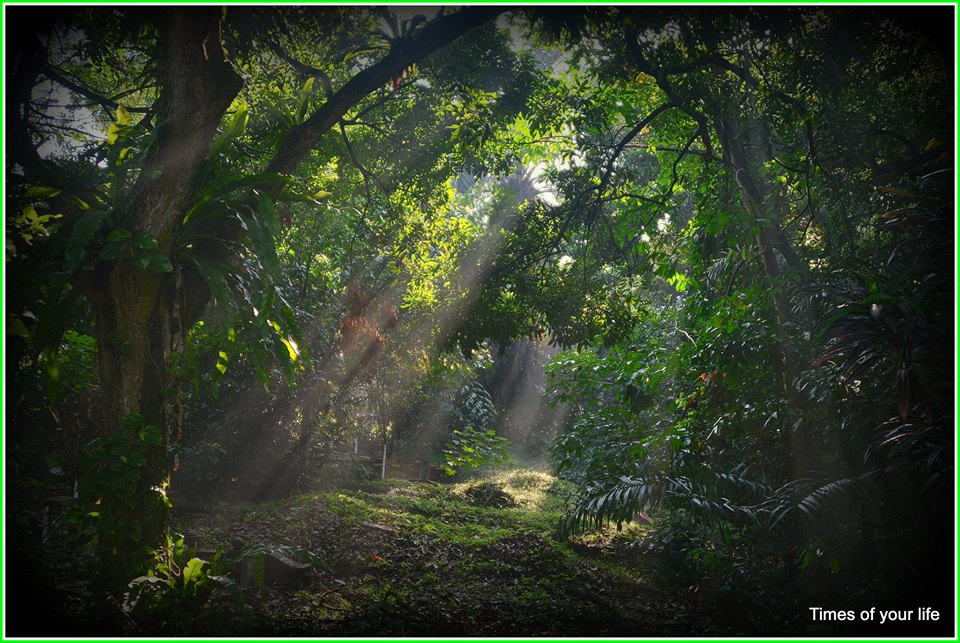


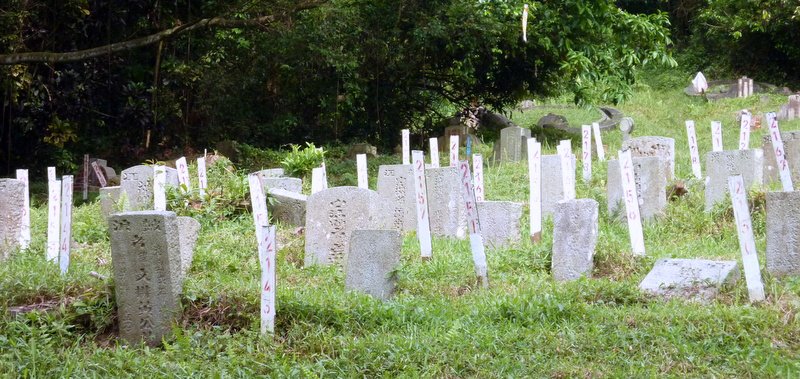
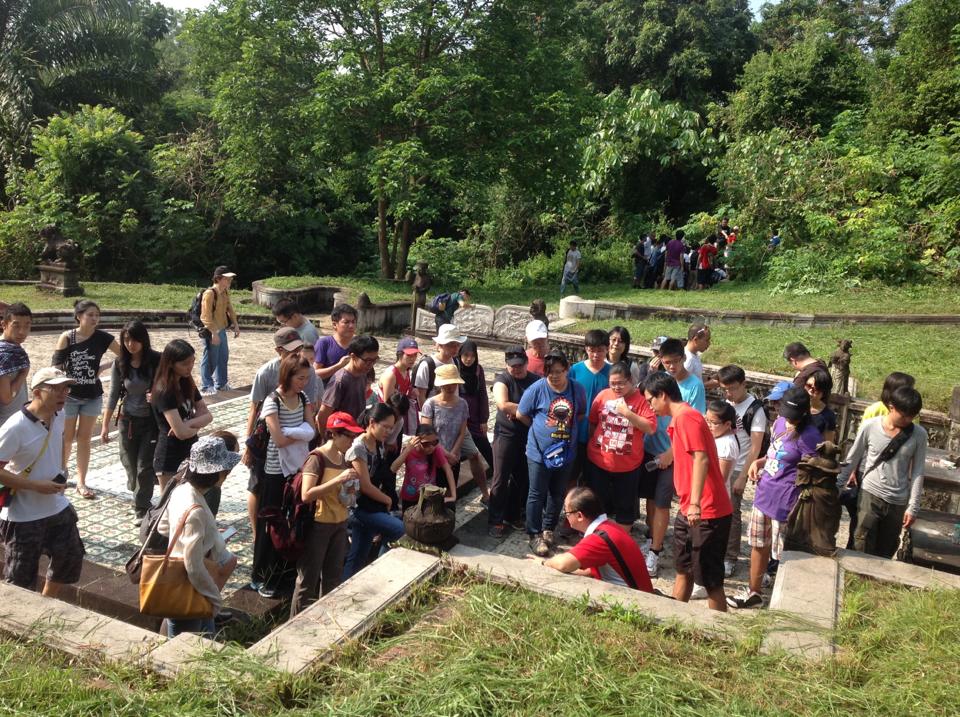
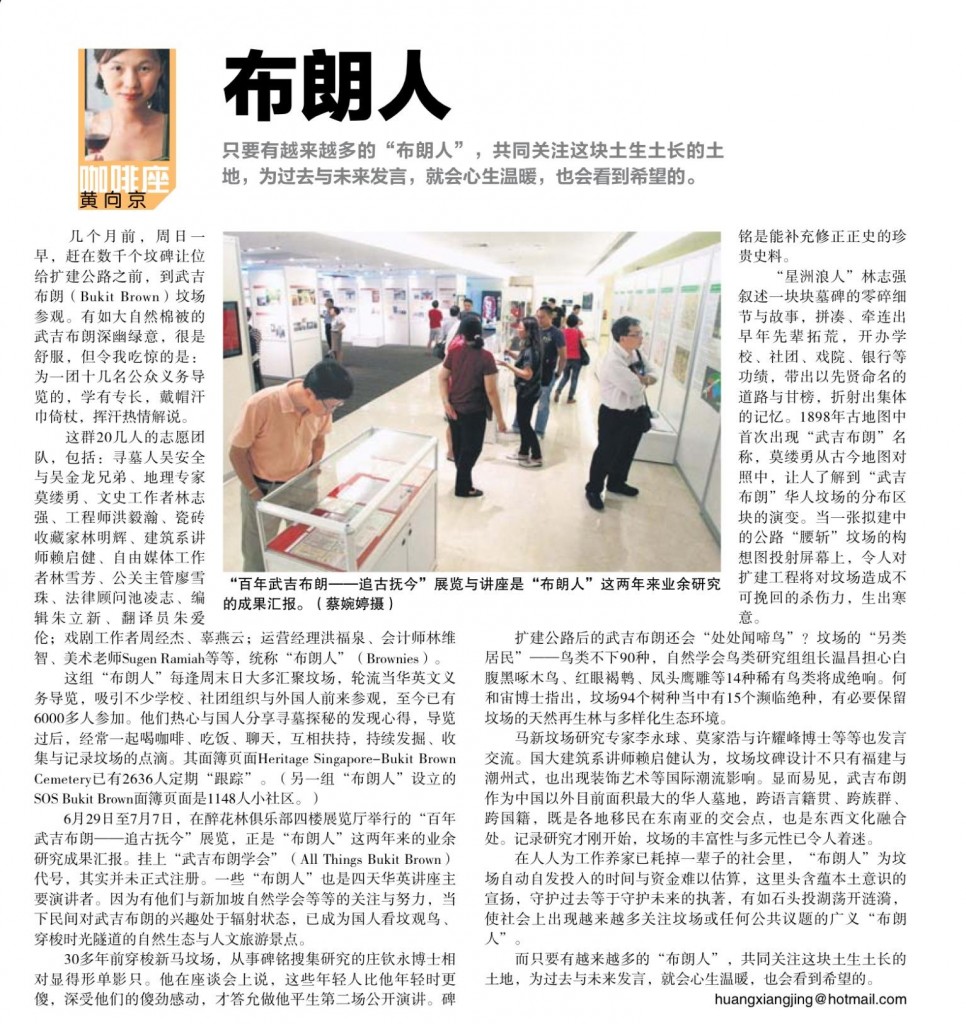
Recent Comments